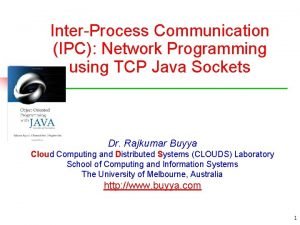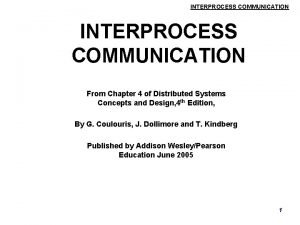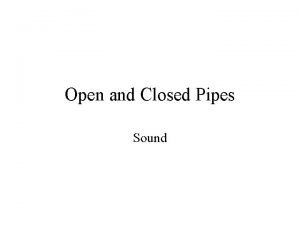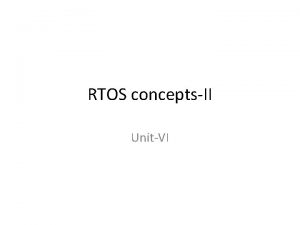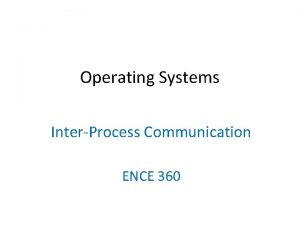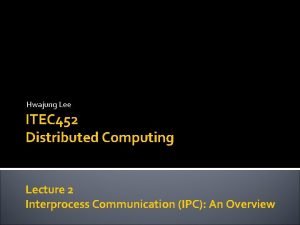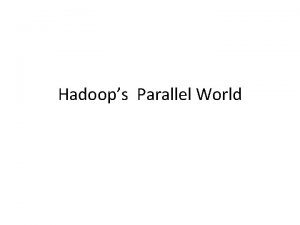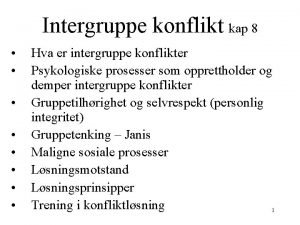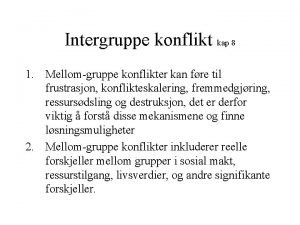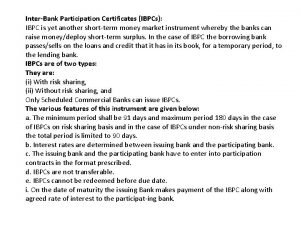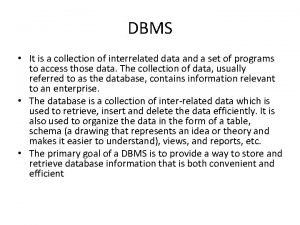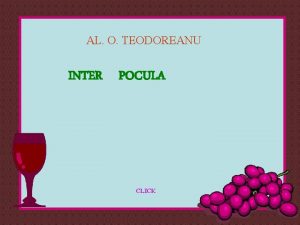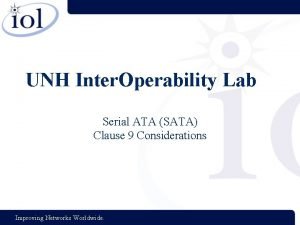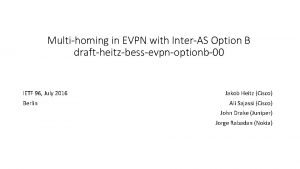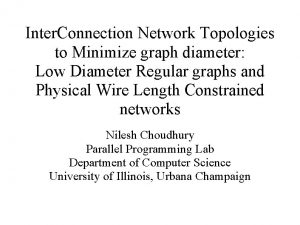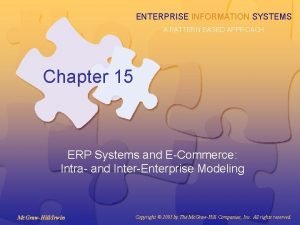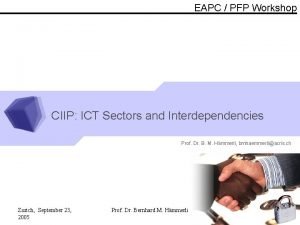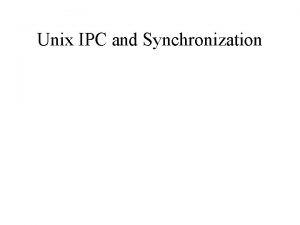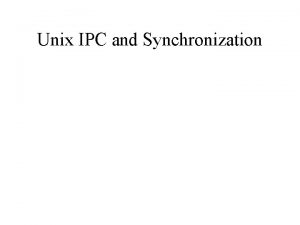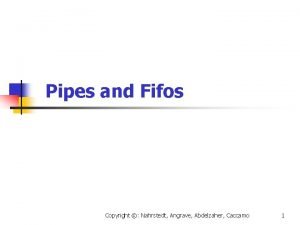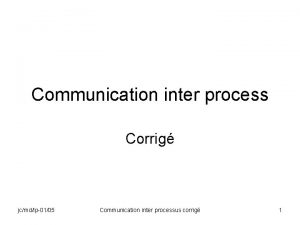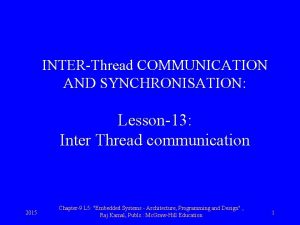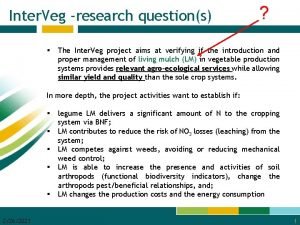Inter Process Communication Pipes and FIFOs named pipes






















































![• struct list_head queue[MAX_PRIO] • An array of linked lists. There is one • struct list_head queue[MAX_PRIO] • An array of linked lists. There is one](https://slidetodoc.com/presentation_image_h/0b9d5520a5c507662bd5dfe0eaacadcf/image-55.jpg)














- Slides: 69

Inter- Process Communication • • • Pipes and FIFO’s (named pipes) Semaphores Messages Shared Memory Regions Sockets

Pipes • One-way flow of data • | operator eg: $ ls | more instead of : $ ls > temp $ temp > more • The shell statement is much shorter and simpler • There is no need to find temporary regular files, which must be deleted later.

System calls for using a pipe • Pipe() • Read() • Write() POSIX : half- duplex pipes System V Release 4 : full-duplex pipes Linux : one-way file descriptors but not necessary to close one of them before using the other

‘ls | more’ example When command shells interprets ‘ls | more’, it: 1. Invokes the pipe( ) system call; let us assume that pipe( ) returns the file descriptors 3 (the pipe's read channel ) and 4 (the write channel ). 2. Invokes the fork( ) system call twice. 3. Invokes the close( ) system call twice to release file descriptors 3 and 4.

‘ls | more’ example The first child process, which must execute the ls program, performs the following operations: 1. Invokes dup 2(4, 1) to copy file descriptor 4 to file descriptor 1. From now on, file descriptor 1 refers to the pipe's write channel. 2. Invokes the close( ) system call twice to release file descriptors 3 and 4. 3. Invokes the execve( ) system call to execute the /bin/ls program. By default, such a program writes its output to the file having file descriptor 1 (the standard output), that is, it writes into the pipe.

‘ls | more’ example The second child process must execute the more program; therefore, it performs the following operations: 1. Invokes dup 2(3, 0) to copy file descriptor 3 to file descriptor 0. From now on, file descriptor 0 refers to the pipe's read channel. 2. Invokes the close( ) system call twice to release file descriptors 3 and 4. 3. Invokes the execve( ) system call to execute /bin/more. By default, that program reads its input from the file having file descriptor (the standard input); that is, it reads from the pipe.

Wrapper functions The popen( ) function receives two parameters: the filename pathname of an executable file and a type string specifying the direction of the data transfer. It returns the pointer to a FILE data structure. The popen( ) function essentially performs the following operations: 1. Creates a new pipe by making use of the pipe( ) system call 2. Forks a new process, which in turn executes the following operations: a. If type is r, duplicates the file descriptor associated with the pipe's write channel as file descriptor 1 (standard output); otherwise, if type is w, duplicates the file descriptor associated with the pipe's read channel as file descriptor 0 (standard input) b. Closes the file descriptors returned by pipe( ) c. Invokes the execve( ) system call to execute the program specified by filename 3. If type is r, closes the file descriptor associated with the pipe's write channel; otherwise, if type is w, closes the file descriptor associated with the pipe's read channel 4. Returns the address of the FILE file pointer that refers to whichever file descriptor for the pipe is still open

Wrapper functions • The pclose( ) function, which receives the file pointer returned by popen( ) as its parameter, simply invokes the wait 4( ) system call and waits for the termination of the process created by popen( ).

Pipe Data Structures For each pipe, kernel creates : • an inode object, – its u field containing the pipe_inode_info structure. – i_size field stores the current pipe size – i_atomic_write semaphore • • two file objects, one for reading and other for writing pipe buffer

Creating a pipe The pipe( ) system call is serviced by the sys_pipe( ) function, which in turn invokes the do_pipe( ) function. In order to create a new pipe, do_pipe( ) performs the following operations: 1. Allocates a file object and a file descriptor for the read channel of the pipe, sets the flag field of the file object to O_RDONLY, and initializes the f_op field with the address of the read_ pipe_fops table. 2. Allocates a file object and a file descriptor for the write channel of the pipe, sets the flag field of the file object to O_WRONLY, and initializes the f_op field with the address of the write_ pipe_fops table. 3. Invokes the get_ pipe_inode( ) function, which allocates and initializes an inode object for the pipe. This function also allocates a page frame for the pipe buffer and stores its address in the base field of the pipe_inode_info structure. 4. Allocates a dentry object and uses it to link together the two file objects and the inode object. 5. Returns the two file descriptors to the User Mode process.

Destroying a pipe Whenever a process invokes the close( ) system call on a file descriptor associated with a pipe, the kernel executes the fput( ) function on the corresponding file object, which decrements the usage counter. If the counter becomes 0, the function invokes the release method of the file operations. • the pipe_read_release( ) and the pipe_write_release( ) functions set 0 to the readers and the writers fields, respectively, of the pipe_inode_info structure. • Each function then invokes the pipe_release( ) function. This function wakes up any processes sleeping in the pipe's wait queue so that they can recognize the change in the pipe state. • Moreover, the function checks whether both the readers and writers fields are equal to 0; in this case, it releases the page frame containing the pipe buffer.

Reading from a pipe A process wishing to get data from a pipe issues a read( ) system call, specifying as its file descriptor the descriptor associated with the pipe's read channel. The kernel ends up invoking the read method found in the file operation table associated with the proper file object. In the case of a pipe, the entry for the read method in the read_pipe_fops table points to the pipe_read( ) function which performs the following operations: 1. Determines if the pipe size, which is stored into the inode's i_size field, is 0. In this case, determines if the function must return or if the process must be blocked while waiting until another process writes some data in the pipe. The type of I/O operation (blocking or nonblocking) is specified by the O_NONBLOCK flag in the f_flags field of the file object. If necessary, invokes the interruptible_sleep_on( ) function to suspend the current process after having inserted it in the wait queue to which the wait field of the pipe_inode_info data structure points.

Reading from a pipe 2. Checks the lock field of the pipe_inode_info data structure. If it is not null, another process is currently accessing the pipe; in this case, either suspends the current process or immediately terminates the system call, depending on the type of read operation (blocking or nonblocking). 3. Increments the lock field. 4. Copies the requested number of bytes (or the number of available bytes, if the buffer size is too small) from the pipe's buffer to the user address space. 5. Decrements the lock field. 6. Invokes wake_up_interruptible( ) to wake up all processes sleeping on the pipe's wait queue. 7. Returns the number of bytes copied into the user address space.

Writing into a pipe A process wishing to put data into a pipe issues a write( ) system call, specifying as its file descriptor the descriptor associated with the pipe's write channel. The kernel satisfies this request by invoking the write method of the proper file object; the corresponding entry in the write_pipe_fops table points to the pipe_write( ) function which performs the following functions: 1. Checks whether the pipe has at least one reading process. If not, sends a SIGPIPE signal to the current process and return an EPIPE value. 2. Releases the i_sem semaphore of the pipe's inode, which was acquired by the sys_write( ) function and acquires the i_atomic_write semaphore of the same inode. The i_sem semaphore prevents multiple processes from starting write operations on a file, and thus on the pipe.

Writing into a pipe 3. Checks whether the number of bytes to be written is within the pipe's buffer size: a. If so, the write operation must be atomic. Therefore, checks whether the buffer has enough free space to store all bytes to be written. b. If the number of bytes is greater than the buffer size, the operation can start as long as there is any free space at all. Therefore, checks for at least 1 free byte. 4. If the buffer does not have enough free space and the write operation is blocking, inserts the current process into the pipe's wait queue and suspends it until some data is read from the pipe. Notice that the i_atomic_write semaphore is not released, so no other process can start a write operation on the buffer. If the write operation is nonblocking, returns the -EAGAIN error code.

Writing into a pipe 5. Checks the lock field of the pipe_inode_info data structure. If it is not null, another process is currently reading the pipe, so either suspends the current process or immediately terminates the write depending on whether the write operation is blocking or nonblocking. 6. Increments the lock field. 7. Copies the requested number of bytes (or the number of free bytes if the pipe size is too small) from the user address space to the pipe's buffer. 8. If there are bytes yet to be written, goes to step 4. 9. After all requested data is written, decrements the lock field. 10. Invokes wake_up_interruptible( ) to wake up all processes sleeping on the pipe's wait queue. 11. Releases the i_atomic_write semaphore and acquires the i_sem semaphore (so that sys_write( ) can safely release the latter). 12. Returns the number of bytes written into the pipe's buffer.

FIFOs • A process creates a FIFO by issuing a mknod( ) system call, passing to it as parameters the pathname of the new FIFO and the value S_IFIFO (0 x 1000) logically ORed with the permission bit mask of the new file. • POSIX introduces a system call named mkfifo( ) specifically to create a FIFO. This call is implemented in Linux, as in System V Release 4, as a C library function that invokes mknod( ). • Once created, a FIFO can be accessed through the usual open( ), read( ), write( ), and close( ) system calls.

Fifo_open( ) 1. The fifo_open( ) function examines the values of the readers and writers fields in the pipe_inode_info data structure.

Fifo_open( ) 2. The function further determines specialized behavior for the set of file operations to be used by setting the f_op field of the file object to the address of some predefined tables shown in Table 18 -5. 3. Finally, the function checks whether the base field of the pipe_inode_info data structure is NULL; in this case, it gets a free page frame for the FIFO's kernel buffer and stores its address in base.

System V IPC • It denotes a set of system calls that allows a User Mode process to : – – – • • • Synchronize itself with other processes by means of semaphores Send messages to other processes or receive messages from them Share a memory area with other processes IPC data structures are created dynamically when a process requests an IPC resource (a semaphore, a message queue, or a shared memory segment). Each IPC resource is persistent: unless explicitly released by a process, it is kept in memory. An IPC resource may be used by any process, including those that do not share the ancestor that created the resource. Each new resource is identified by a 32 -bit IPC key, which is similar to the file pathname in the system's directory tree. Each IPC resource also has a 32 -bit IPC identifier, which is somewhat similar to the file descriptor associated with an open file. When two or more processes wish to communicate through an IPC resource, they all refer to the IPC identifier of the resource.

Using an IPC resource • By invoking the semget( ), msgget( ), or shmget( ) functions, IPC identifier is derived from the corresponding IPC key, which is then used to access the resource. • If there is no IPC resource already associated with the IPC key, a new resource is created. • If everything goes right, the function returns a positive IPC identifier; otherwise, it returns one of the error codes illustrated in Table 18 -6.

Using an IPC resource • The ftok( ) function attempts to create a new key from a file pathname and an 8 -bit project identifier passed as parameters. It does not guarantee, however, a unique key number. • One process issues a semget( ), msgget( ), or shmget( ) function by specifying IPC_PRIVATE as its IPC key. A new IPC resource is thus allocated, and the process can either communicate its IPC identifier to the other process in the application or fork the other process itself. • IPC_CREAT flag specifies that the IPC resource must be created, if it does not already exist. • IPC_EXCL flag specifies that the function must fail if the resource already exists and the IPC_CREAT flag is set.

Using an IPC resource • Each IPC identifier is computed by combining a slot usage sequence number s relative to the resource type, an arbitrary slot index i for the allocated resource, and the value chosen in the kernel for the maximum number of allocatable resources M, where 0 i<M IPC identifier = s x M + i • At every allocation, slot index i is incremented. • At every deallocation, the slot usage sequence number s, which is initialized to 0, is incremented by 1 while i decreases.

Using an IPC resource • The semctl( ), msgctl( ), and shmctl( ) functions may be used to handle IPC resources. – The IPC_SET subcommand allows a process to change the owner's user and group identifiers and the permission bit mask in the ipc_perm data structure. – The IPC_STAT and IPC_INFO subcommands retrieve some information concerning a resource. – The IPC_RMID subcommand releases an IPC resource. • • • A process may acquire or release an IPC semaphore by issuing the semop( ) function. When a process wants to send or receive an IPC message, it uses the msgsnd( ) and msgrcv( ) functions, respectively. A process attaches and detaches a shared memory segment in its address space by means of the shmat( ) and shmdt( ) functions, respectively.

IPC semaphores • IPC semaphores are counters used to provide controlled access to shared data structures for multiple processes. • The semaphore value is positive if the protected resource is available, and negative or 0 if the protected resource is currently not available. • A process that wants to access the resource decrements by 1 the semaphore value. • It is allowed to use the resource only if the old value was positive; otherwise, the process waits until the semaphore becomes positive. • When a process relinquishes a protected resource, it increments its semaphore value by 1; in doing so, any other process waiting for the semaphore is woken up.

IPC semaphores • Each IPC semaphore is a set of one or more semaphore values, called primitive semaphores, not just a single value as for kernel semaphores. • The number of primitive semaphores in each IPC semaphore must be specified as a parameter of the semget( ) function when the resource is being allocated, but it cannot be greater than SEMMSL (usually 32). • When a process chooses to use this mechanism, the resulting operations are called undoable semaphore operations. When the process dies, all of its IPC semaphores can revert to the values they would have had if the process had never started its operations.

IPC semaphores To access one or more resources protected by an IPC semaphore, a process: 1. Invokes the semget( ) wrapper function to get the IPC semaphore identifier, specifying as the parameter the IPC key of the IPC semaphore that protects the shared resources. If the process wants to create a new IPC semaphore, it also specifies the IPC_CREATE or IPC_PRIVATE flag and the number of primitive semaphores required. 2. Invokes the semop( ) wrapper function to test and decrement all primitive semaphore values involved. If all the tests succeed, the decrements are performed, the function terminates, and the process is allowed to access the protected resources. If some semaphores are in use, the process is usually suspended until some other process releases the resources. The function receives as parameters the IPC semaphore identifier, an array of numbers specifying the operations to be atomically performed on the primitive semaphores, and the number of such operations. Optionally, the process may specify the SEM_UNDO flag, which instructs the kernel to reverse the operations should the process exit without releasing the primitive semaphores. 3. When relinquishing the protected resources, invokes the semop( ) function again to atomically increment all primitive semaphores involved. 4. Optionally, invokes the semctl( ) wrapper function, specifying in its parameter the IPC_RMID flag to remove the IPC semaphore from the system.

IPC semaphore data structures

IPC semaphore data structures semary array: • Statically allocated • Includes SEMMNI values (usually 128) • Each element in the array can assume one of the following values: – IPC_UNUSED (-1): no IPC resource refers to this slot. – IPC_NOID (-2): the IPC resource is being allocated or destroyed. – The address of a dynamically allocated memory area containing the IPC semaphore resource. • Index number of array represents the slot index i. • When a new IPC resource must be allocated, the kernel scans the array and uses the first array element (slot) containing the value IPC_UNUSED.

IPC semaphore data structures • The first locations of the memory area containing the IPC semaphore store a descriptor of type struct semid_ds. • All other locations in the memory area store several sem data structures with two fields: – semval – sempid

Undoable semaphore operations • Processes may require undoable operations by specifying the SEM_UNDO flag in the semop( ) function. • sem_undo data structure contains – the IPC identifier of the semaphore, and – an array of integers representing the changes to the primitive semaphore's values caused by all undoable operations • per-process list – used when a process terminates • per-semaphore list – used when a process invokes the semctl( ) function to force an explicit value into a primitive semaphore – used when an IPC semaphore is destroyed

IPC semaphore data structures The queue of pending requests:

IPC Messages • A message is composed of: – a fixed-size header, which is a data structure of type msg – a variable-length text

IPC message queue data structures

IPC message queue data structures

Sending and Receiving Messages • msgsnd( ) function; parameters : – The IPC identifier of the destination message queue – The size of the message text – The address of a User Mode buffer that contains the message type immediately followed by the message text • msgrcv( ) function; parameters: – The IPC identifier of the IPC message queue resource – The pointer to a User Mode buffer to which the message type and message text should be copied – The size of this buffer – A value t that specifies what message should be retrieved

IPC Shared Memory • • shmget( ) function shmat( ) function shmdt( ) function shmctl( ) function – accesses the contents of the shmid_ds data structure named u inside the shmid_kernel structure which is IPC shared memory descriptor.

IPC shared memory data structures

IPC Shared Memory Data Structures

Demand paging for IPC shared memory segments • “Page Fault” occurs when a process tries to access a location of shared memory segment. • Exception handler invokes the do_no_page function. • It invokes nopage method and the page table entry is set to the address returned by it. (The usage counter of the page frame is increased. )

Swapping out pages of IPC shared memory segments • try_to_sawp_out( ) function : – page frame is not released to the Buddy system – its usage counter is decremented by 1 – corresponding entry in the calling process’s page table is cleared. • do_try_to_free_pages( ) function periodically invokes shm_swap( ) function, which – iteratively scans all descriptors referenced by the shm_segs array – for each descriptor, examines all page frames assigned to each segment – if the usage counter of a page frame is found to be 1, that page is swapped out to the disk – the swapped out page identifier is saved in the shm_pages array.

LINUX SCHEDULING (version 2. 6. x)

• Linux is a multitasking kernel that allows more than one process to exist at any given time • A kernel’s scheduler enforces a thread scheduling policy, including when, for how long, and in some cases where (on Symmetric Multiprocessing (SMP) systems) threads can execute. Normally the scheduler runs in its own thread, which is woken up by a timer interrupt. Otherwise it is invoked via a system call or another kernel thread that wishes to yield the CPU. • A thread will be allowed to execute for a certain amount of time , then a context switch to the scheduler thread will occur, followed by another context switch to a thread of the scheduler’s choice.

CPU and I/O-bound Threads • CPU Bound : Threads spend a lot of time doing CPU computation. eg. Video Encoder. • I/O Bound : Threads spend a lot of time waiting for relatively slow I/O operations. eg. VI ( Text Editor)

Linux Kernel 2. 6 • Molnar designed this scheduler with the desktop and the server market in mind, and as a result desktop performance is much improved in Linux distributions based on 2. 6. x kernels.

Linux Scheduling Goals • Efficiency : Every algorithm is O(1) regardless of number of running processes. • Provide good interactive performance. • Provide fairness : No process should find itself starved of timeslice for any reasonable amount of time. Likewise, no process should receive an unfairly high amount of timeslice. • Soft RT Scheduling : RT tasks are assigned special scheduling modes and the scheduler gives them priority over any other task on the system.

POLICY • Determines what runs when!!! • Responsible for optimally utilizing processor time & overall feel of the system.

Linux Policy • CPU bound processes are scheduled less frequently but are given longer timeslice. • I/O bound processes are scheduled for short periods and more frequently. • Leading to improved process response time at the cost of process throughput.

There are two key data structures in the Linux 2. 6. 8. 1 scheduler that allow for it to perform its duties in O(1) time, and its design revolves around them – runqueues and priority arrays.

RUNQUEUE • Runqueue keeps track of all runnable tasks assigned to a particular CPU. As such, one runqueue is created and maintained for each CPU in a system. • Each runqueue contains two priority arrays, tasks on a CPU begin in one priority array, the active one, and as they run out of their timeslices they are moved to the expired priority array. During the move, a new timeslice is calculated. When there are no more runnable tasks in the active priority arrays, it is simply swapped with the expired priority array (simply updating two pointers). • Runqueue also keep track of a CPU’s special thread information (idle thread, migration thread).

RUNQUEUE DATASTRUCTURE struct runqueue { spinlock_t lock; spin lock which protects this runqueue unsigned long nr_running; number of runnable tasks unsigned long nr_switches; number of contextswitches unsigned long expired_timestamp; time of last array swap unsigned long nr_uninterruptible; number of tasks in uinterruptible sleep struct task_struct *curr; this processor's currently running task struct task_struct *idle; this processor's idle task

struct mm_struct *prev_mm; mm_struct of last running task struct prio_array *active; pointer to the active priority array struct prio_array *expired; pointer to the expired priority array struct prio_arrays[2]; the actual priority arrays int prev_cpu_load[NR_CPUS]; load on each processor struct task_struct *migration_thread; the migration thread on this processor struct list_head migration_queue; the migration queue for this processor atomic_t nr_iowait; number of tasks waiting on I/O }

PRIORITY ARRAY • This data structure is the basis for most of the Linux 2. 6. 8. 1 scheduler’s advantageous behavior, in particular its O(1) (constant) time performance. • The Linux 2. 6. 8. 1 scheduler always schedules the highest priority task on a system, and if multiple tasks exist at the same priority level, they are scheduled roundrobin with each other. • Priority arrays make finding the highest priority task in a system a constant-time operation, and also makes round -robin behavior within priority levels possible in constanttime. • Furthermore, using two priority arrays in unison (the active and expired priority arrays) makes transitions between timeslice epochs a constant-time operation. • An epoch is the time between when all runnable tasks begin with a fresh timeslice and when all runnable tasks

Priority Array Datastructure • unsigned int nr_active The number of active tasks in the priority array. • unsigned long bitmap[BITMAP_SIZE] The bitmap representing the priorities for which active tasks exist in the priority array. It is stored in form of 5 32 -bit words. For example - if there are three active tasks, two at priority 0 and one at priority 5, then bits 0 and 5 should be set in this bitmap. Because the number of priorities is constant time to search the first set bit.
![struct listhead queueMAXPRIO An array of linked lists There is one • struct list_head queue[MAX_PRIO] • An array of linked lists. There is one](https://slidetodoc.com/presentation_image_h/0b9d5520a5c507662bd5dfe0eaacadcf/image-55.jpg)
• struct list_head queue[MAX_PRIO] • An array of linked lists. There is one list in the array for each priority level (MAX_PRIO). • In Linux kernel 2. 6. x MAX_PRIO is 140.

Priorities STATIC PRIORITY • All tasks have a static priority, often called a nice value. On Linux, nice values range from -20 to 19, with higher values being lower priority. By default, tasks start with a static priority of 0, but that priority can be changed via the nice() system call. Apart from its initial value and modifications via the nice() system call, the scheduler never changes a task’s static priority. Static priority is the mechanism through which users can modify task’s priority, and the scheduler will respect the user’s input. • A task’s static priority is stored in its static_prio variable.

Priorities DYNAMIC PRIORITY • Scheduler rewards I/O-bound tasks and punishes CPU-bound tasks by adding or subtracting from a task’s static priority. • This adjusted priority is dynamic priority and is stored in p->prio. • Maximum Priority bonus & penalty is 5.

I/O-bound vs. CPU-bound Heuristics • To determine how much penalty or bonus has to be given to a process scheduler keeps track of how long the process sleeps as opposed to running during its time slice. • When a task is woken up from sleep, its total sleep time is added to its sleep_avg variable (limiting the max value to MAX_SLEEP_AVG) • When a task gives up the CPU, voluntarily or involuntarily, the time the current task spent running is subtracted from its sleep_avg.

Calculating dynamic priority • The sleep_avg value is used to determine the DP as it is an index of how much process is I/O bound or CPU bound • effective_prio() – It checks whether the function is RT or not, If it is RT then no bonus. – It maps the sleep_avg value to bonus in range -5 to 5 which is then subtracted from the static priority to get DP.

Calculating Timeslice • Timeslice is calculated by simply scaling a task’s static priority onto the possible timeslice range and making sure a certain minimum and maximum timeslice is enforced. (task_timeslice()) • The higher the task’s static priority (the lower the task’s static_prio value) the larger the timeslice it gets.

• Interactive task’s timeslice may be broken up into chunks, based on the TIMESLICE_GRANULARITY value in the scheduler. • The function scheduler_tick() (called after every 1 msec) checks to see if the currently running task has been taking the CPU from other tasks of the same dynamic priority for too long (TIMESLICE_GRANULARITY). • If a task has been running for TIMESLICE_GRANULARITY and task of the same dynamic priority exists a round-robin switch between other tasks of the same dynamic priority is made.

Reinsertion of interactive task • If a task is sufficiently interactive, when it exhausts its timeslice, it will not be inserted into the expired array, but instead reinserted back into the active array(so long as nothing is starving in the expired priority array checked by EXPIRED_STARVING() called by scheduler_tick())

Fairness when forking new tasks • When new tasks (threads or processes) are forked, the functions wake_up_forked_thread() and wake_up_forked_process() decrease the sleep avg of both parents and children. • This prevents highly interactive tasks from spawning other highly interactive tasks.

Interactivity Credits • Every task maintains an interactive_credit variable. • Tasks get an interactive credit when they sleep for a long time, and lose an interactive credit when they run for a long time. • If a task has less then -100 interactivity credits it is considered to have low interactivity credit. • Low interactivity credit tasks waking from uninterruptible sleep are limited in their sleep avg rise since they are probably CPU hogs waiting on I/O. • High interactivity credit tasks get less run time subtracted from their sleep avg in order to prevent them from losing interactive status too quickly.

SLEEPING & WAKING TASKS

Wait queue • A wait queue is essentially a list of tasks waiting for some event or condition to occur. • When that event occurs, code controlling that event will tell the waitqueue to wake up all of the tasks in it.

Going to Sleep • • Create a wait queue via DECLARE_WAITQUEUE(). Add task to the wait queue via add_wait_queue(). To wake tasks when the event occurs : wake_up() Mark task as sleeping, either TASK_INTERRUPTIBLE or TASK_UNINTERRUPTIBLE. • calls schedule() • When the task wakes up, mark task as TASK_RUNNING and remove it from the wait queue via remove_wait_queue().

Interruptible & Uninterruptible states • Uninterruptible state : Ignores any signal until the event it was originally waiting for occurs. • Interruptible state : respond to the signal immediately (though their response won’t necessarily be to die as the user probably wants).

Main Scheduling Function • Pick a new task to run and switch to it. • Called whenever a task wishes to give up the CPU voluntarily (often through the sys_sched_yield() system call), and if scheduler_tick() sets the TIF_NEED_RESCHED flag on a task because it has run out of timeslice. • scheduler_tick() is a function called during every system time tick, via a clock interrupt. It checks the state of the currently running task and other tasks in a CPU’s runqueue to see if scheduling is necessary.
 Ipc programming
Ipc programming Interprocess communication in distributed systems
Interprocess communication in distributed systems What is inter function communication in c
What is inter function communication in c Thread.abort alternative c#
Thread.abort alternative c# The limited access zone of a masonry wall must be
The limited access zone of a masonry wall must be Smart endpoints and dumb pipes
Smart endpoints and dumb pipes Open tubes
Open tubes Ben has had problems with the pipes in his apartment
Ben has had problems with the pipes in his apartment Heat pipes for electronics cooling applications
Heat pipes for electronics cooling applications Plastic pipes uae
Plastic pipes uae Ccdcfe happy birthday
Ccdcfe happy birthday Rtos mailbox
Rtos mailbox Pastoral
Pastoral Offshore pipes
Offshore pipes Ence pipes
Ence pipes Lee pipes
Lee pipes Hwajung
Hwajung Uilleann pipes
Uilleann pipes Pvc pan flute
Pvc pan flute Flow through pipes
Flow through pipes Benefits of inter firm comparison
Benefits of inter firm comparison Intrapersonal skills example
Intrapersonal skills example Inter and trans firewall analytics
Inter and trans firewall analytics Inter and intra personal skills
Inter and intra personal skills Characteristics of multiprocessors
Characteristics of multiprocessors Difference between interpersonal and intrapersonal
Difference between interpersonal and intrapersonal Bodily kinesthetic intelligence
Bodily kinesthetic intelligence Thyromental distance
Thyromental distance Inter pointer
Inter pointer Surplomb et recouvrement dentaire
Surplomb et recouvrement dentaire Força potente e força resistente
Força potente e força resistente Intertext meaning
Intertext meaning Intermolecular forces in a lava lamp
Intermolecular forces in a lava lamp Intermolecular force of attraction
Intermolecular force of attraction Intergruppekonflikt
Intergruppekonflikt Mellomgrupperelasjoner
Mellomgrupperelasjoner Inter bank participation certificates
Inter bank participation certificates O que é
O que é Inter ikea systems b.v. 2017
Inter ikea systems b.v. 2017 Inter american accreditation cooperation
Inter american accreditation cooperation Complemento di causa interna esterna e impediente
Complemento di causa interna esterna e impediente Department accounts are prepared to ascertain
Department accounts are prepared to ascertain Database languages
Database languages Inter intra extra
Inter intra extra Lab - configure router-on-a-stick inter-vlan routing
Lab - configure router-on-a-stick inter-vlan routing Routing and switching protocols
Routing and switching protocols Rai inter
Rai inter Inter pocula
Inter pocula Sniffing position for intubation
Sniffing position for intubation Inter incisor gap
Inter incisor gap Sosyolinggwistikang teorya
Sosyolinggwistikang teorya Inter ata
Inter ata Gened psu
Gened psu Complemento vantaggio latino
Complemento vantaggio latino Inter as option b
Inter as option b Losange inter trachéo pulmonaire
Losange inter trachéo pulmonaire Parallel arbitration logic
Parallel arbitration logic Intra versus inter
Intra versus inter Inter diameter
Inter diameter College passphrase
College passphrase Inter rater reliability cheat sheet
Inter rater reliability cheat sheet Inter club cassino
Inter club cassino Interaksi berasal dari kata
Interaksi berasal dari kata Objective vs subjective tests in psychology
Objective vs subjective tests in psychology Classification duparc et alnot
Classification duparc et alnot Truncus coeliacus
Truncus coeliacus Inter rater reliability 中文
Inter rater reliability 中文 Inter link survey
Inter link survey Inter enterprise information system
Inter enterprise information system Inter pfp
Inter pfp
